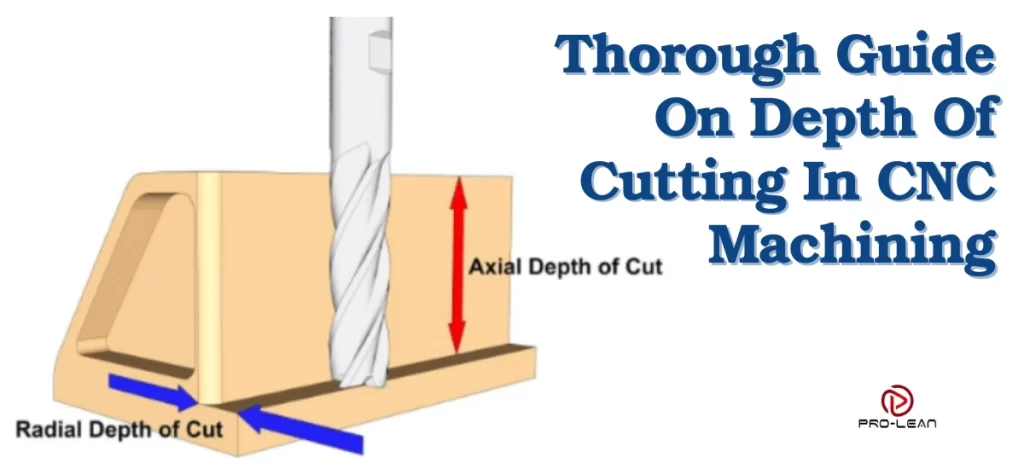
Depth of cutting
Every CNC machining process is based on a fundamental concept – depth of cutting (DOC). This is the distance the cutting tool digs into the workpiece, and it normally has an axial and radial dimension.
The radial depth of cut (RDOC) is from the surface of the workpiece towards the centerline while the Axial depth of cut (ADOC) is measured along the centerline.
No matter the type, machining to the correct depth is critical. It has an effect on not only product quality but also durabilty of cutting tools and other aspects of the process. That’s why your custom parts manufacturer is always keen on optimizing the depth of cut for every machining process.
This article looks into the meaning of depth of cutting, determination of DOC in various machining processes, and the interaction of DOC with other machining processes, among other issues.
How Do You Describe The Depth Of A Cut?
The depth of cutting or cut refers to the depth to which the cutting tool goes in each pass during the machining process. It is a crucial parameter given that it affects the surface finish, the machining rate, and the process’ cycle time.
During the machining process, the cutting tool typically moves radially and axially. These two give rise to two types of depth of cutting : Radial depth of cut (RDOC) and Axial depth of cut (ADOC).
Radial Depth Of Cut (RDOC)
This means the distance the tool is eating into the workpiece. This type of depth of cut is critical in milling machining.
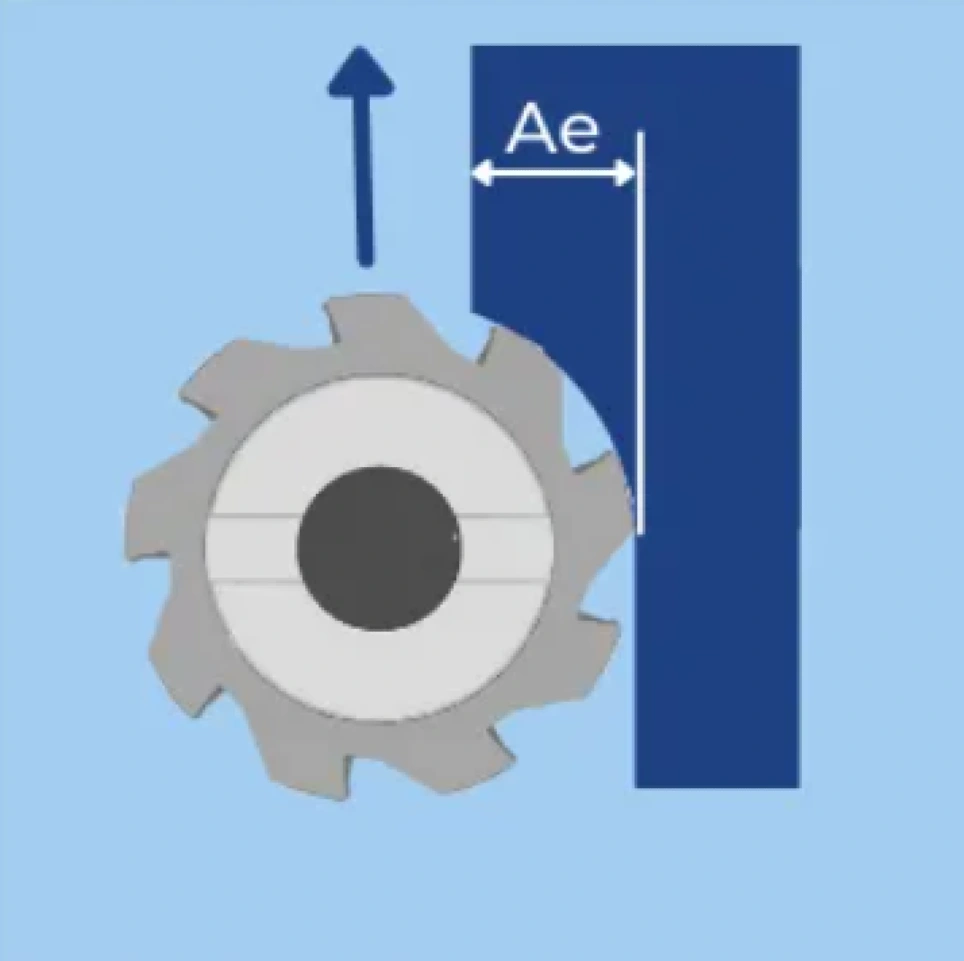
Radial depth of cut
Axial Depth Of Cut (ADOC)
This is the distance the tool is moving along the centerline of the workpiece. It is also called the cut depth or step down.
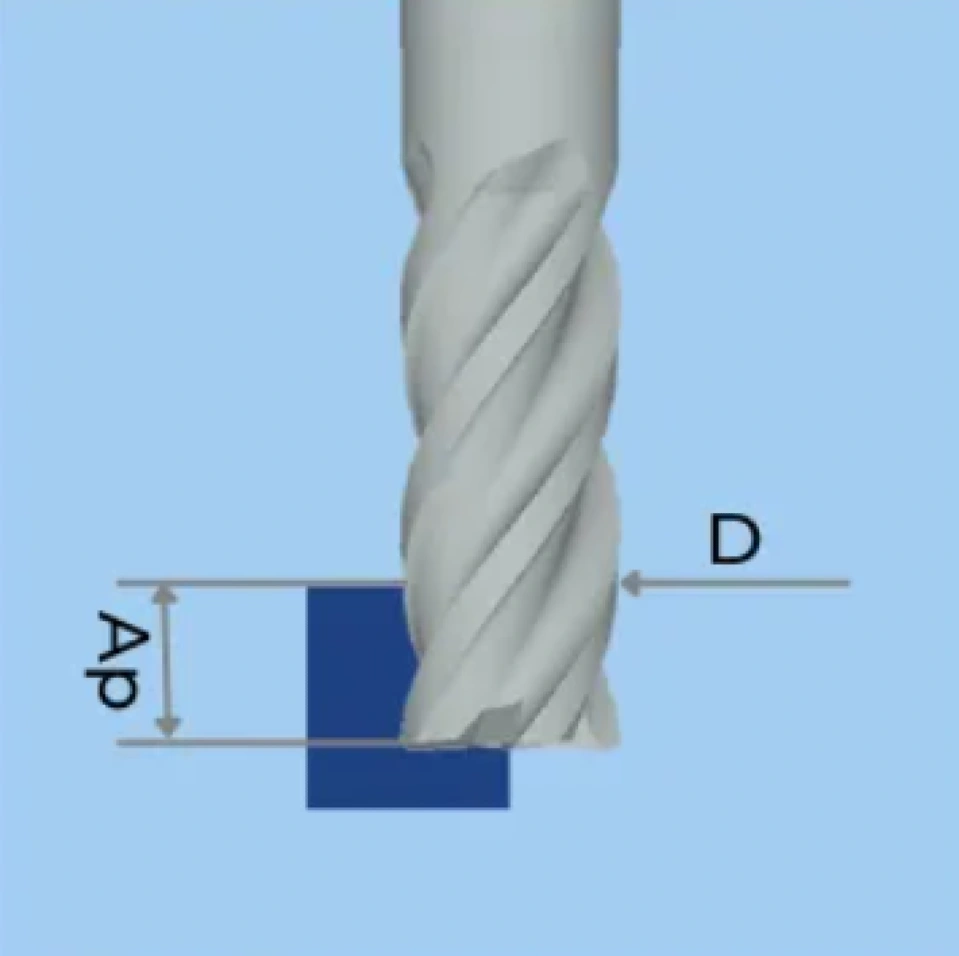
Axial depth of cut
What Is The Importance Of Depth Of Cutting In CNC Machining?
Having established the meaning of depth of cutting, it is important now to recognize its relevance in CNC machining. As intimated, the DOC affects different aspects of machining including accuracy, speed, surface finish, and even the overall CNC machining cost.
So, DOC isn’t just technical jargon for machinists – it is essential in several aspects, as you can discover as you learn all about CNC machining.
Here are some of them:
Heat Generation In The Tool
Various studies have revealed that the depth of cut is the biggest contributor to heat generation and the tip of the cutting tool, more than even the feed rate and spindle speed. This heat generation affects both the cutting tool and the workpiece.
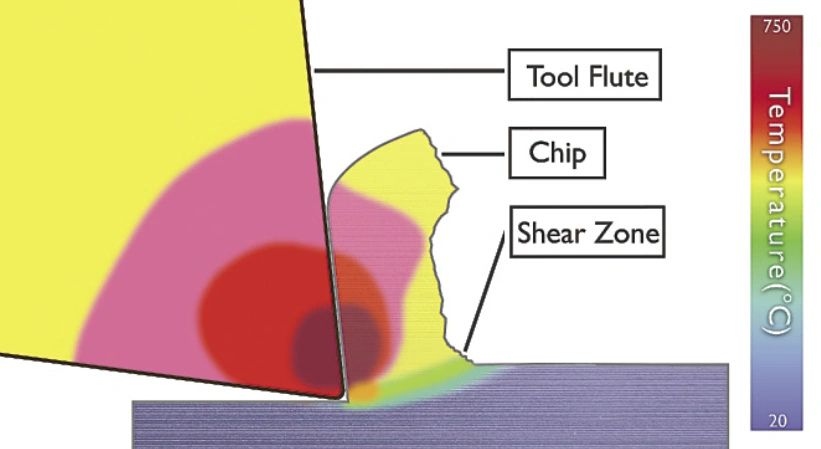
Heat generation on cutting tool
Optimizing the depth of cut is an effective strategy to enhance tool life. While a deep cut is good for reducing the overall machining time, tool large depth has its disadvantages such as heat generation, tool breakage, and higher cutting forces.
You may wonder what is deep cut? This is typically a depth of cut that is significantly deep compared to the tool size and material thickness.
Strength Of The Machined Product
The depth of cutting can affect the strength of the CNC machined part. If the process is not well optimized, it can easily end up weakening the part. Overly deep cuts can introduce unwanted stresses in the component, which make it unreliable.
Surface Finish Of The Product
Research and real-case CNC precision machining has proven that increases in depth of cut and feed go hand in hand with surface roughness value. Therefore, it is important to control these parameters for the best quality surface finish.

Surface roughness vs depth of cut and feed rate
Cutting Tool Wear
Every machinist desires to extend the life of the cutting tool as much as possible. However, this may be affected by improper selection or calculation of the depth. Deeper cuts mean more friction on the cutting tool, which translates to faster wear. These cuts also expose the tool to higher risk of breakage.
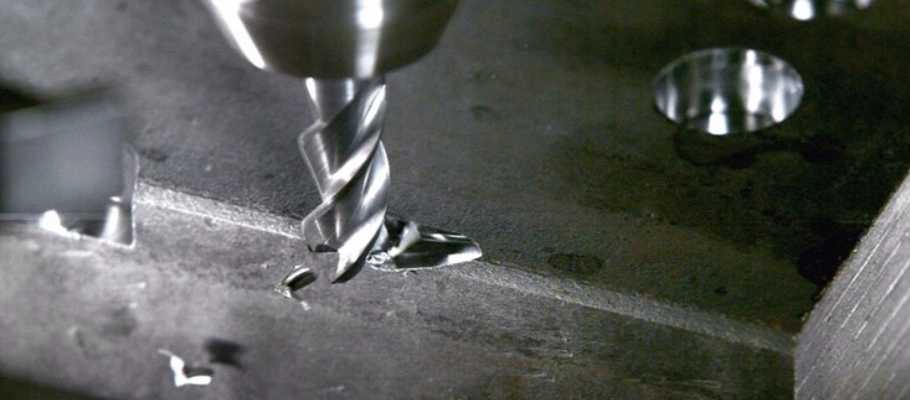
Broken cutting tool
Try Prolean Now!
How To Calculate The Depth Of Cutting
As the depth of cutting is critical, knowing how to calculate it is the hallmark of quality CNC machining. There is a standard method of determining this parameter, and each machining operation has its requirements. Key operations considered in calculating the depth of cutting are CNC turning and CNC milling.
Apart from the machining operation, other factors to consider when calculating the depth of cutting are;
- CNC machine capability
- Workpiece material
- Desired surface finish
- Nature of the cutting tool
Depth Of Cutting In CNC Turning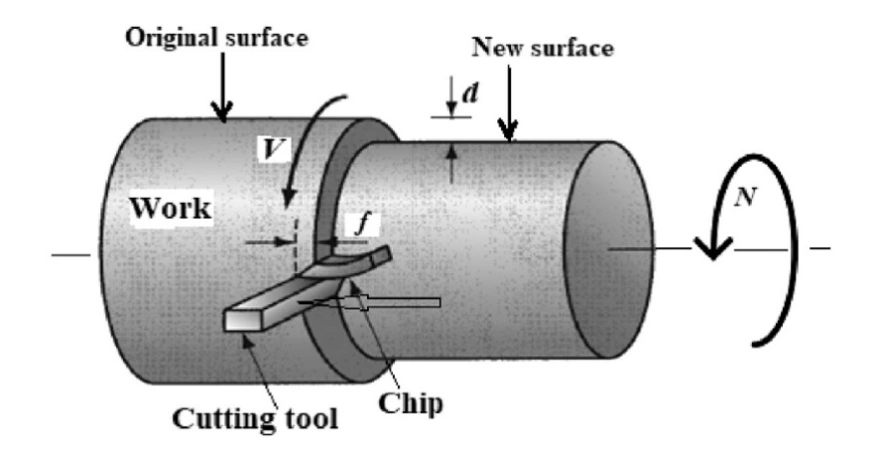
Depth of cut in CNC turning
CNC turning is characterized by the workpiece turning while the cutting tool is stationary. The depth of cut for this operation is typically the radial entry of the cutting tool into the workpiece.
The standard formula for the DOC is given as;
DOC = (Initial diameter – final diameter)/2
Here is a sample cutting calculation:
A steel shaft is CNC turned from 65mm to 60mm. The depth of cutting per pass is:
DOC=(65.0−60.0)/2=2.5 mm
| Parameter | Value |
| Initial diameter | 65mm |
| Final diameter | 60mm |
| DOC per pass | 2.5mm |
Depth Of Cutting In CNC Milling
In CNC milling operations, the tool typically rotates above the material and removes material vertically. Therefore, the depth of the cut is measured vertically. There is also the horizontal movement of the tool as it extends the machined surface.
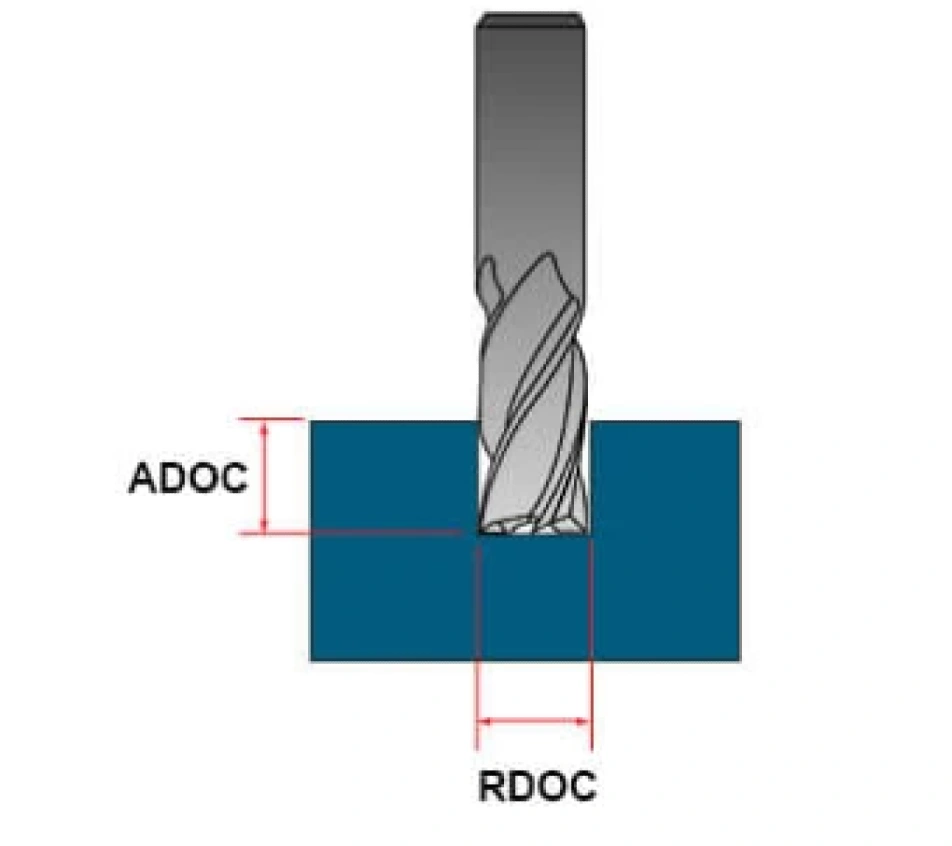
Depth of cut in CNC milling
Like calculating the DOC in CNC turning, CNC milling does have a standard formula. The formula is:
DOC = Total depth cut – Depth of previous pass
Yes, it is straightforward, but there are some guidelines related to the tool diameter that make the result even more predictable.
Here are the main guidelines for this process:
- For cutting tool diameter over 20mm, use DOC as 4* the tool diameter
- For cutting tool diameter less than 20mm, use DOC as 10* the tool diameter
Note, it is important to always confirm if the forces emanating from these values are safe for the CNC milling operation.
What Is The Depth Of Cut Of A Drill?
In drilling jobs, there is not much consideration of the radial depth. The drill penetrates the workpiece entirely.
What Is The Cutting Depth Of An End Mill?
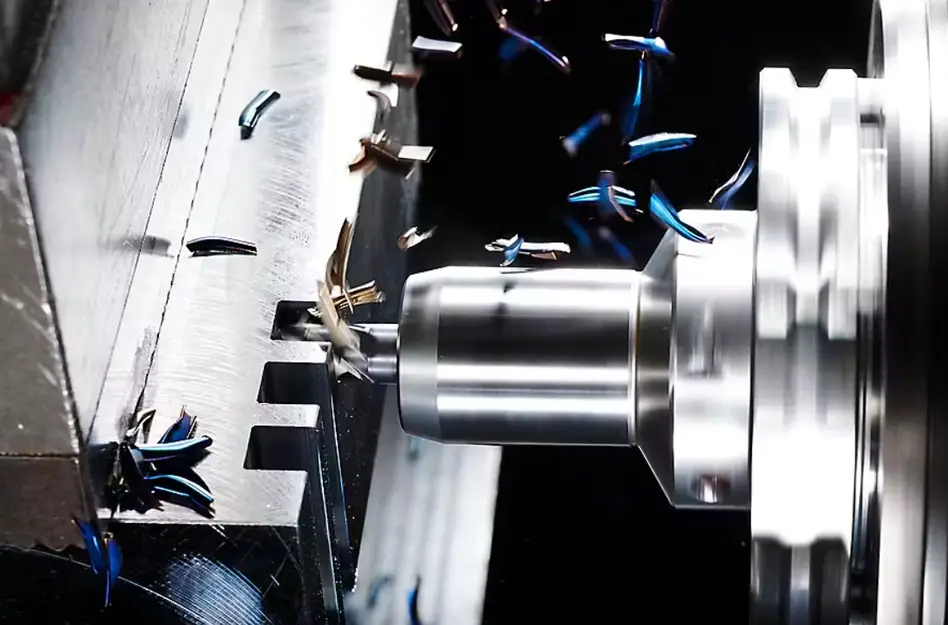
CNC end milling
For the end mill case, there is a table to use to determine the DOC based on the cutting tool size. The table is as shown below:
| End milling tool diameter (mm) | Range of axial DOC (mm) | Maximum DOC (mm) |
| 3 | 0.3 – 0.6 | 1.5 |
| 6 | 0.6 – 1.2 | 3 |
| 10 | 1-2 | 5 |
| 12 | 1.5 – 2.5 | 6 |
| 16 | 2 – 3.5 | 8 |
| 20 | 2.5 – 4 | 10 |
| 25 | 3 – 5 | 12 |
Try Prolean Now!
What Is The Depth Of Cut For Roughing And Finishing?

Surface finishing
In roughing and finishing operations, specifically for turning, the allowable radial depth of cutting is relatively small. However, the axial DOC can vary because it largely depends on the tool geometry and the capabilities of the CNC machine.
Compared to finishing passes, roughing passes typically involve larger ADOC.
Setting Up Depth Of Cutting In CNC Machining
The recommendations given above and others for the rest of the processes are actionable through a series of steps. Here is a simple process of setting up the DOC of any CNC machining process.
- Refer to the tool manufacturer’s manual for cutting parameter charts
- Determine the nature of machining, for instance, whether finishing or roughing
- Calculate the potential DOC using software or manual formulas
- If on a new machine or machining a new material, start the cut slowly/with a shallower depth of cutting. Monitor the surface finish, tool wear, and vibrations as you slowly increase the depth
- Remember to run a dry run or simulation before the real machining just to make sure the tool holds and doesn’t crush instantly.
Tuning Depth of Cutting for Better CNC Results
Even with keen CNC machining planning, choosing the ideal setting for depth of cutting can be a tough call. The slightest setting errors or overlooks can lead to cutting tool chattering, unattractive surface finish, and fast tool wear.
Knowing how to calculate and set up the depth of cutting sets the stage for applying these insights strategically in the CNC machining process. Optimizing the depth of cut directly influences the cutting accuracy, speed, and tool wear.
Machining Accuracy And Speed
A way to guarantee good CNC machining results in finding a balance between machining speed and accuracy. If the cutting speed is to be increased, it should be in a way that it doesn’t jeopardize the machining accuracy.
Cutting Tool Wear And Life
Still related to speed, this balance can affect the condition of the tool. Too much speed without a proportionate adjustment to the speed can generate too much force on the tool. This can result in accelerated tool wear or even breakage, which can also be hazardous to the CNC machine and machinist.
Considerations For CNC Machine And Workpiece Material
The capabilities of the CNC machine and the type of workpiece material have a bearing on the allowable depth of cut. CNC machines that are more stable and powerful can handle deeper cutting.
The material properties also determine the ideal depth of cutting. For aluminum and other soft materials, a cut of 1-2 mm is acceptable. The depth of cut is smaller for harder materials such as titanium and steel. It should typically be in the range of 0.5mm to 1.0mm.
Difference Between Depth Of Cutting And Chip Thickness
There is a common misconception that depth of cut and chip thickness are one and the same thing. Nothing can be further from the truth. The diagram below demonstrates how different these concepts are.
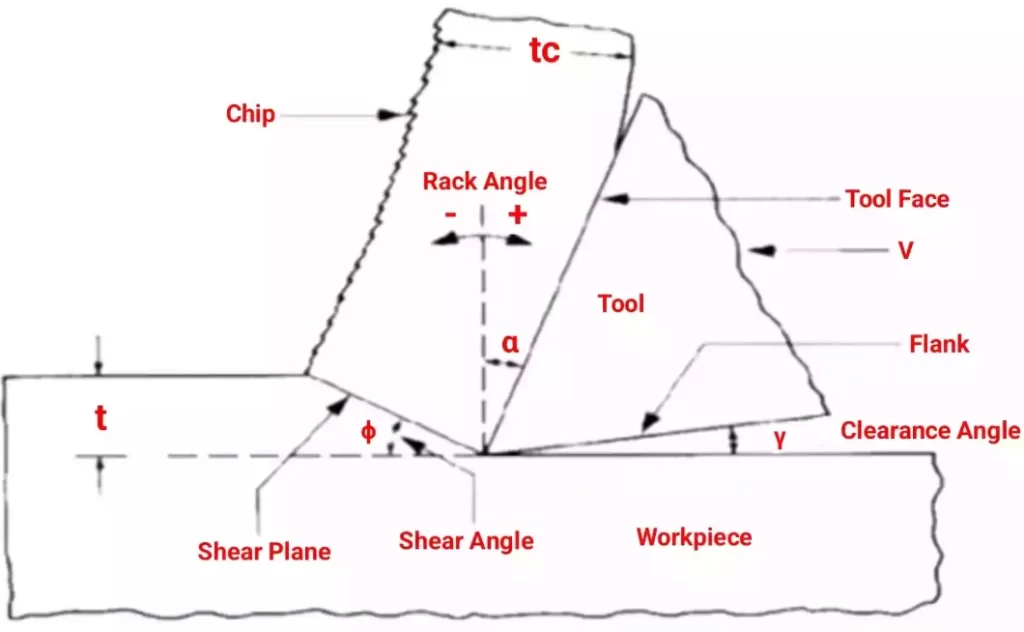
Depth of cut vs chip thickness
As you can see from the diagram, the size and orientation of the two is different. The chip is always thicker than the DOC due to the shear angle ϕ derived from the shear plane.
Effects Of Depth Of Cutting On Other Machining Factors
Depth of cutting is essential and far-reaching in CNC machining, so it is expected it would affect other CNC machining services factors. CNC machining parameters, cutting tool geometry (rake angle), and cooling fluid are some of the other machining factors that correlate with the DOC.
CNC Machining Parameters – Cutting Speed
The cutting speed and feed rate are popular factors in tool life. However, depth of cut is equally influential in theis respect. It is important to find a balance between cutting speed and depth of cut for not only optimum machining results but also enhanced tool life.
Cutting Tool Geometry – Rake Angle
When CNC machining, the tool geometry in terms of the rake angle and the cutting speed should be optimized to factor in the various thermal conductivities of materials. The idea is to prevent heat generation at the tool tip and the formation of sticky chips.
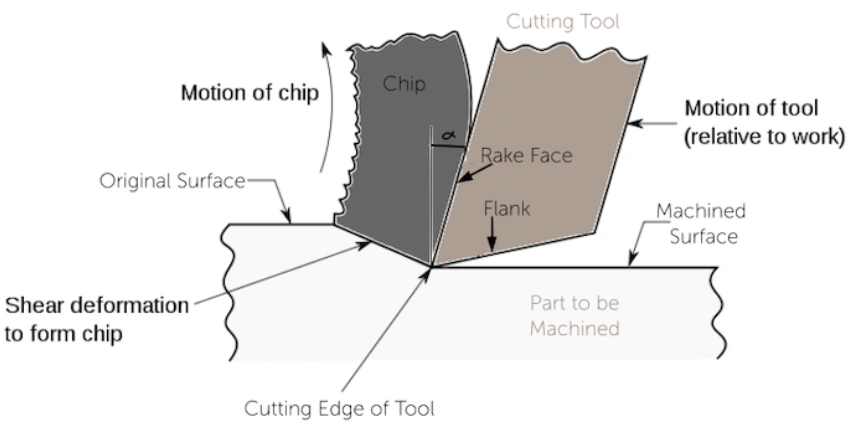
Rake angle
Cooling Fluid
The interrelation between depth of cut and required administration of the cooling fluid is interesting. Most people would think that the amount of cooling fluid should increase as the cut gets deeper. However, it does not work like that.
A larger depth makes the chip curl more due to increased curvature. Increasing the coolant enhances this curvature. The effect is reduction in the contact surface area between the chip and the cutting tool, which leads to more heat concentration on the tool. This is a recipe for faster deterioration of the tool.
Conclusion
The depth of cutting in machining is a critical parameter that affects the CNC machine performance, the surface finish, tool wear, and many other factors. When well-analyzed and chose, this depth optimizes machining results and overall part quality.
At ProleanTech, a seasoned team is behind all CNC operations. They ensure every process optimizes depth of cutting in accordance to client requirements and industry standards. That’s how we are able to continuously meet demands and remain competitive.
No matter your need for quality CNC machined parts, minimal cycle times, and consistent results, you can always rely on our CNC machining services.
Contact us today to learn more!

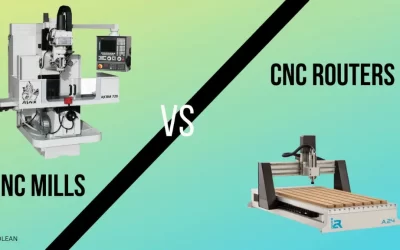
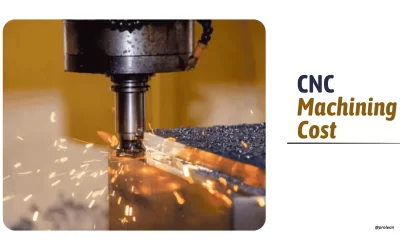
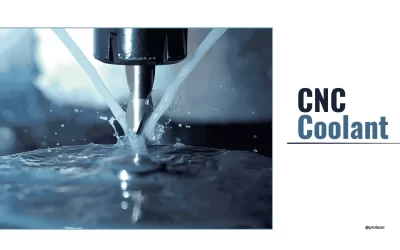
0 Comments